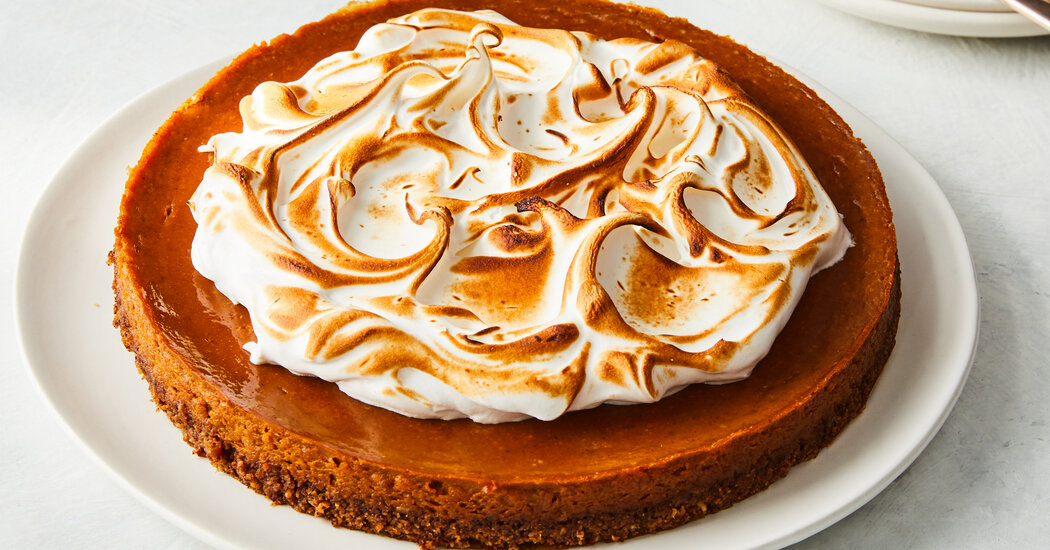
In “Amelia Bedelia,” the first volume of the children’s book series created by Peggy Parish, the title character starts a new job as a housekeeper. Before she gets to her long list of tasks, she bakes a pie with ease, even joy, because she does “make a good pie.” She then follows the instructions for her duties literally — when asked to dust the furniture, she sprinkles powder all over it.
Her boss is so infuriated that she plans to fire her, but Amelia’s pie instantly changes her mind. It’s so delicious that the woman forgets her anger, and even vows to change her way of leaving instructions. (“Undust the furniture.”)
With Thanksgiving approaching, I think often of that story. As a child (OK, sometimes even as an adult), I sincerely believed that baking a good pie could fix everything.
On its own, food cannot heal wounds or quell past or present tensions, but it can be a small kindness, especially at the Thanksgiving table, and especially when cooking for those with dietary restrictions.
Accommodating allergies is nonnegotiable, but preparing dishes for those who can’t or prefer to not eat gluten or dairy can be an act of grace. These two dishes — savory sticky rice stuffing and pumpkin meringue pie — will make those guests feel that you care. And it may be a cliché, but it’s true: They’re delicious enough for everyone to enjoy.
Nothing compares to buttery bread stuffing, so instead of trying to mimic it, make another stuffing that shares its best qualities: chewiness and richness. Short-grain sticky rice, sometimes labeled sushi rice, doesn’t have any gluten but does have a satisfying soft bite quite unlike the texture of the austere wild rice used in North American nut and dried-fruit stuffings.
In my Chinese American upbringing, our family matriarch stuffed the turkey with gingery sticky rice as an adaptation of more traditional Chinese stuffed ducks and chickens. In his book, “Mister Jiu’s in Chinatown,” written with Tienlon Ho, the chef Brandon Jew shares his recipe for noh mai gai (quail with sticky rice) and describes it as “the Chinese equivalent to turkey and stuffing.”
For my starchy turkey side, I took inspiration from that dish, in which the rice steams into a cohesive whole in lotus leaves, and another Cantonese sticky rice specialty, yau mei faan, in which the grains stay distinct when simply stirred on the stovetop. One key commonality the two share is the combination of fatty pork and meaty mushrooms, which makes the rice grains savory and even plumper. Instead of tossing in a pinch of ginger, I throw in a handful and sizzle the finely chopped pieces until they’re crisp, their sharp heat mellowing into warm, fragrant crunchy bits.
With a balance of saltiness from the cured pork and the natural sweetness of sticky rice, the finished dish fits well into any Thanksgiving spread. And because it cooks entirely on the stovetop, it doesn’t take up precious oven space.
This pumpkin meringue pie does, but can be baked up to a few days ahead, then simply topped with the meringue before serving. With a pecan crust and pumpkin filling enriched by coconut milk, this dessert blends two Thanksgiving standards — and also works for those who don’t eat gluten or dairy. Fluffy and swirly, the meringue topping delivers the airiness of whipped cream, and the singed ridges offer the delightful bittersweetness of burnt marshmallow.
The press-in crust, toasty with ground nuts and oats, is a welcome new base for spiced pumpkin custard. It’s such a departure from a typical pie dough that guests won’t compare it to a customary flaky crust, which is hard to replicate without wheat flour. They’ll just enjoy its unique nuttiness.
Even the most accomplished makers of traditional crusts are starting to meet this need. Alan Nugent co-founded Stockholm Pie & General Store in a Wisconsin river village (population: 76) with his husband, Steve Grams, and his sister Janet Garretson 15 years ago. They’re well-known for their exceptional flaky pie crust. Mr. Nugent said that in the late 1970s, Ms. Garretson learned her crust-making technique from “an elderly German farm woman” while serving as a pastor’s wife in western Kansas.
Now they are considering adding a nut-crust option. “We never even thought about gluten-free pie really,” Mr. Nugent said. “We just thought, ‘Gluten-free pie crusts are gross, so we won’t make them.’” But the shop began receiving requests for gluten-free pie four years ago — by this point, Ms. Garretson had retired — and after a lot of experimenting, the Stockholm Pie team came up with a “pretty good” replica of their beloved original crust. There are already twice as many gluten-free orders this season as last Thanksgiving.
And increasingly, those requests are part of orders that include regular pies too, an indication that hosts are taking different guests’ dietary preferences into consideration. Whether you buy a pie or bake your own, offering one that all guests can eat may just bring a little Amelia Bedelia magic to the meal.



